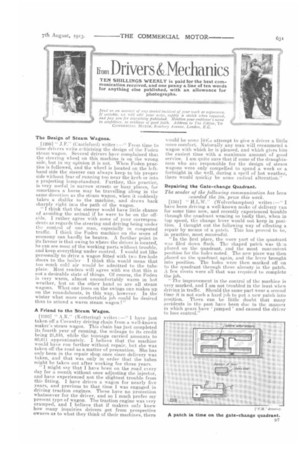hm. Drivers &Mechanics
Page 19

If you've noticed an error in this article please click here to report it so we can fix it.
TEN SHILLINGS WEEKLY is paid for the best communication received, and one penny a line of ten words for anything else published, with an allowance for photographs.
Send 1LS an account of any special incident of your work or experience. If suitable, we will edit your notes, suMily a sketch when required, and pay you for everything published. Mention your employer's name in confidence, as evidence of good faith. Address to The Editor, IV COMMERCIAL MOTOR, Rosebery Avenue, London, E.C.
The Design of Steam Wagons.
[1290] " J.F." (CaStieford) writes :—" From time to time drivers write criticising the design of the Foden steam wagon. Several drivers have complained that the steering wheel on this machine is on the wrong side, but in my opinion it is not. When Foden practice is followed, and the wheel is located on the lefthand side the steerer can always keep to his proper side without fear of running too near the kerb or into a projecting lamp-standard. Further, this practice, is very useful in narrow streetr: or busy places, for sometimes a horse may be travelling along in the same direction as the steam wagon, when it suddenly takes a dislike to the machine, and draws back sharply right. into the path of the wagon.
"I think that the steerer would have little chance of avoiding the animal if he were to be on the offside. I rather agree with some of your correspondents as regards the steering and driving being under the control of one man, especially in congested traffic. I think the Foden machine on the score of economy can hardly be beaten. A further point in its favour is that owing to where the driver is located, he can see most of the working parts without trouble, and keep everything under control. I would not like personally to drive a wagon fitted with two fire-hole doors to the boiler • I think this would mean that too much cold air would be admitted to the tube plate. Most readers will agree with me that this is not a desirable state of things. Of course, the Foden is very warm, almost uncomfortably warm in hot weather, but on the other hand so are all steam wagons. What one loses on the swings one makes up. on the roundabouts, in this way, however. In the winter what more comfortable job could be desired than to attend a warm steam wagon'?"
A Friend to the Steam Wagon.
[1200] " (Kettering) writes :—" I have just taken off a Coventry driving chain from a well-known maker's steam wagon. This chain has just completed its fourth year of running, the mileage to its credit being 21,516, while the tonnage carried amounts to 60,611 approximately. I believe that the machine would have run further without repair, but she was taken off the road as a matter of precaution. She has only been in the repair shop once since delivery was taken, and that was only in order that the tubes might be taken out after working for three years.
I might say that I have been on the road every day for a month without once adjusting the injector, and have experienced not the. slightest trouble from this fitting. I have driven a wagon for nearly five years, and previous to that time I was engaged in driving traction engines. These have no protection whatsoever for the driver, and so I much prefer my present type of wagon. The traction engine was very cramped, and I believe that if makers only knew how many inquiries drivers get from prospective owners as to what they think of their machines, there would be some lit.C.e attempt to give a driver a little more comfort. Naturally any man will rectimmend a wagon with which he is pleased, and which gives him the easiest time with a maximum amount of good service. I am quite sure that if some of the draughtsmen who are responsible for the design of steam wagons were only compelled to spend a week or a fortnight in the well, during a spell of hot weather, there would quickly be sonic radical alteration."
Repairing the Gate-change Quadrant.
The sender of the following communication has been ol..arded the Ws. prize this week.
[1:101] " H.L.W." (Wolverhampton) writes :—" I have been driving a well-known make of delivery van for some time now, and recently experienced trouble through the quadrant wearing so badly that, when in top speed, the change lever would not keep in position. I thought out the following way of effecting a repair by means of a patch. This has proved to bc, in practice, most successful. " In the first place, the worn part. of the quadrant was filed down flush. The shaped patch was then placed on the quadrant, and the most convenient position for the holes noted. The new piece was then placed on the, quadrant again, and the lever brought into position. The holes were then marked off on to the quadrant through those already in the patch. A few rivets were all that was required to complete the job. " The improvement in the control of the machine is very marked, and I am not troubled in the least when driving in traffic. Should the same part wear a second time it is not such a hard job to put a new patch into position. There can be little doubt that many accidents in the past have been due to the, mantle/ in which gears have 'jumped' and caused the driver to lose control."




















